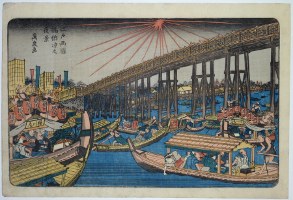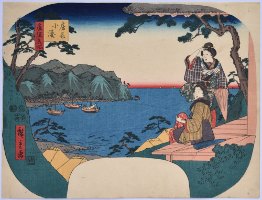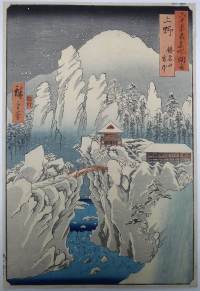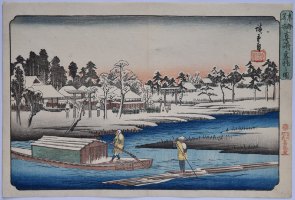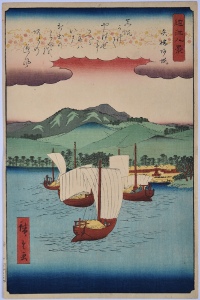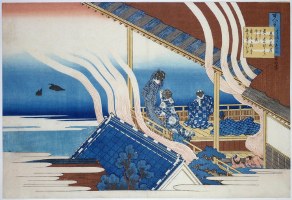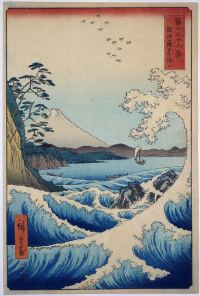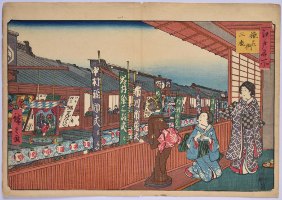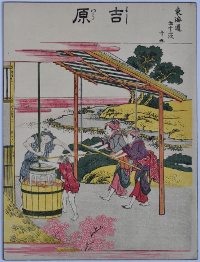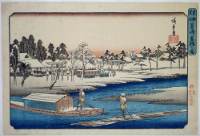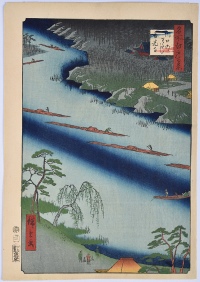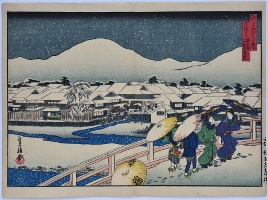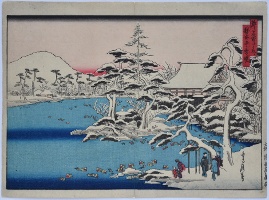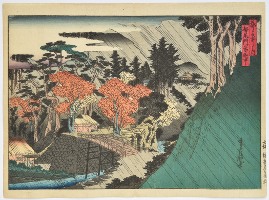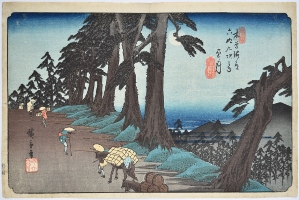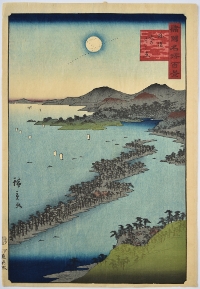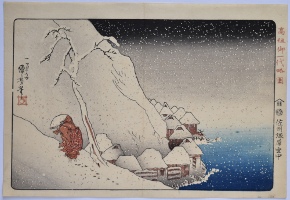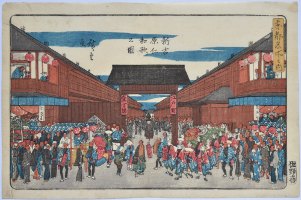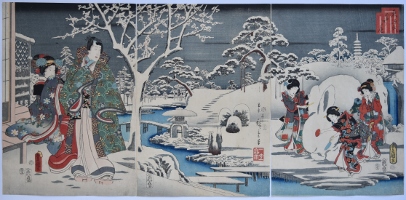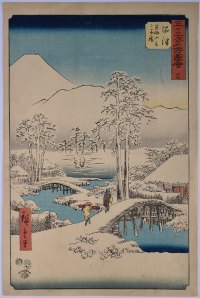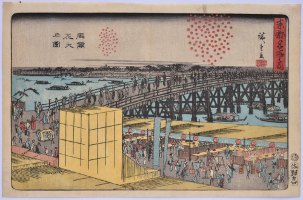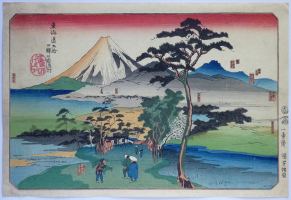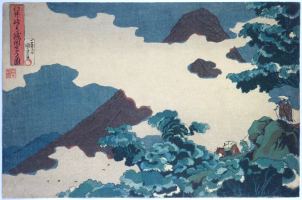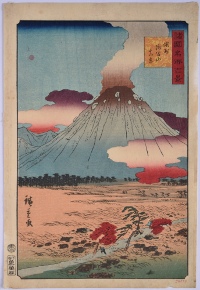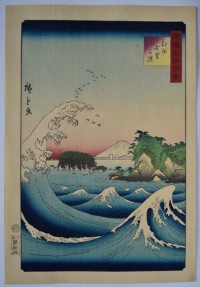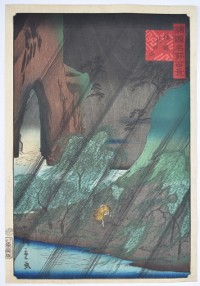Utagawa HIROSHIGE (1797-1858)
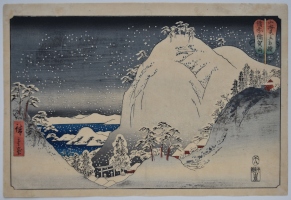
Click here to view image full size.
Harima Tatsuyama, “Mount Tatsu [Dragon] in Harima [Province]” from a set of twenty prints Sankai mitate zumo, “Wrestling Matches Between Mountains and Sea.” A fanciful and imaginative title lacking in other Hiroshige sets. Comprises of ten prints of mountains and ten prints of harbours. A fine snow scene. Published by Yamadaya Shojiro, 1858. The title is in a wrestling umpire’s fan (gunbai).
Fine impression of the first edition: Later printings have a solid red in the title cartouche instead of variegated colour and lack other subtleties. Fine colour with oxidation. Very slight discoloration in top right margin and imperceptible centre fold, otherwise very good condition. Signed Hiroshige ga.
Status: Sold
Toyohara CHIKANOBU (1838-1912)
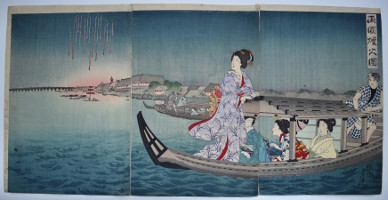
Click here to view image full size.
A triptych Ryogoku hanabi zu, “Fireworks at Ryogoku.” Chikanobu designed a number of triptychs on this subject and boating on the Sumida River, but this is the best and rarest. The government in 1733 had a display of fireworks over the bridge called the Ryogoku kawabiraki hanabi, “Ryogoku River-opening Fireworks” as part of a memorial service for the victims of starvation due to crop failures and an epidemic of cholera. This became an annual event.
Fine impression and colour. Minor marks, otherwise very good condition. Signed Toyohara Chikanobu.
Status: Sold
Utagawa HIROSHIGE (1797-1858)
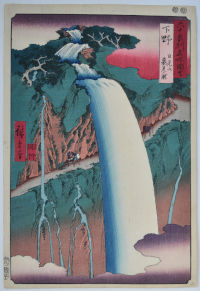
Click here to view image full size.
Shimotsuke Nikkosan urami no taki, “Back-viewed Waterfall on Mt. Nikko in Shimotsuke [Province}.” From a set of 69 prints [Dai Nihon] Rokujuyoshi meisho zue, “Famous Places in the Sixty-odd Provinces [of Japan]” published by Koshihei between 1853 and 1856, this being 1853. Figures gaze up at the back of the waterfall which thunders over the path. It is also known with variant colour schemes. A fine design.
Very fine impression with strong blind-printing on the fall. Very fine colour. Light album backing, otherwise fine condition. Signed Hiroshige ga.
Status: Sold
Utagawa HIROSHIGE (1797-1858)
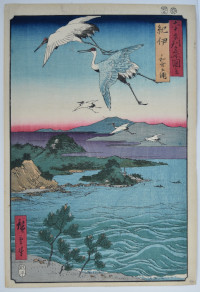
Click here to view image full size.
Kii Wakanoura, “Waka Bay in Kii [Province}.” From a set of 69 prints [Dai Nihon] Rokujuyoshi meisho zue, “Famous Places in the Sixty-odd Provinces [of Japan]” published by Koshihei between 1853 and 1856, this being 1855. Shows cranes taking off from the bay.
Very fine impression and colour. Light album backing, otherwise fine condition. Signed Hiroshige ga.
Status: Sold
Utagawa HIROSHIGE (1797-1858)
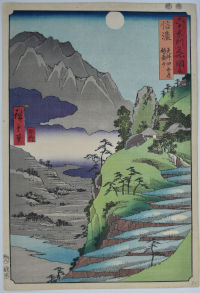
Click here to view image full size.
Shinano, Sarashina tagoto no tsuki Kyodaisan, “The Moon Reflected in the Sarashina Paddy-fields, Mt. Kyodai, Shinano [Province}.” From a set of 69 prints [Dai Nihon] Rokujuyoshi meisho zue, “Famous Places in the Sixty-odd Provinces [of Japan]” published by Koshihei between 1853 and 1856, this being 1853. It was a popular outing to view the multiple images of the moon reflected in the pools.
Very fine impression and colour. Light album backing, otherwise fine condition. Signed Hiroshige ga.
Status: Sold
Utagawa HIROSHIGE II (1826-1869)
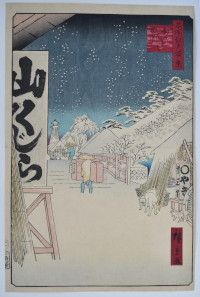
Click here to view image full size.
Bikunibashi setchu, “Bikuni Bridge in Snow.” From the set Meisho Edo hyakkei, “One Hundred Views of Edo.” The set published by Uoya Eikichi 1856-58 (this being 1858). Bikuni Bridge was known for its cheap restaurants. On the right is a sign advertising that imo are roasted whole. (Yakimono were roasted sweet potatoes.) On the left is another sign advertising yama kujiri, “mountain whale.” (In fact wild boar meat. Whale was considered a fish and therefore not forbidden.)
Superb impression of the rare first edition.Very fine colour. Imperceptible centre fold, otherwise fine condition. Signed Hiroshige ga.
Status: Sold
Utagawa HIROSHIGE II (1826-1869)
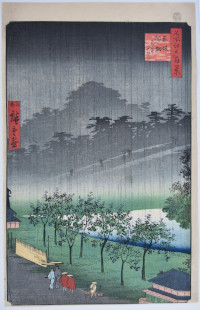
Click here to view image full size.
Akasaka kiribatake uchi yukei, “Evening View of the Paulownia Plantation at Akasaka under rain.” From the set Meisho Edo hyakkei, “One Hundred Views of Edo.” The set published by Uoya Eikichi 1856-58 (this being 1859: a replacement print for Hiroshige’s for which the blocks were probably damaged).
Very good impression with mica sprinkled across the top. Very good colour. Trimmed close at bottom, otherwise very good condition. Signed Nisei “second” Hiroshige ga.
Status: Sold
Utagawa HIROSHIGE II (1826-1869)
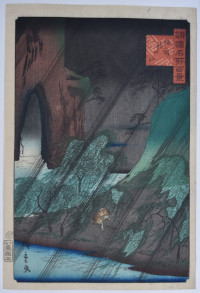
Click here to view image full size.
The Dragon’s Maw Mountain, Bizen Province, Bizen tatsu-no-kuchiyama from an unfinished set Shokoku meisho hyakkei, “One Hundred Views of Famous Places in the Provinces” published by Uoya Eikichi between 1859 and 1861 (this being 1861). Shows a lone figure battling a heavy rainstorm in a steep-sided canyon.
Superb impression of the first edition. Fine colour and condition. Signed Hiroshige ga.
Status: Sold
Utagawa HIROSHIGE (1797-1858)
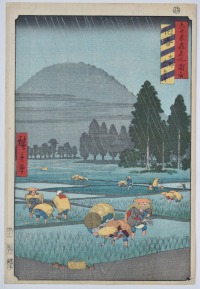
Click here to view image full size.
Hoki, ono Daisen enbo, “Hoki [Province], Distant View of Mount Daisen.” Shows rice-planting in the rain, with the volcanic mountain in the background. From a set of 69 prints [Dai Nihon] Rokujuyoshi meisho zue, “Famous Places in the Sixty-odd Provinces [of Japan]” published by Koshimuraya Heisuke between 1853 and 1856, this being 1853.
Very fine impression and colour. The rain printed with gofun. Light album backing, otherwise fine condition. Signed Hiroshige ga.
Status: Sold
Utagawa HIROSHIGE (1797-1858)
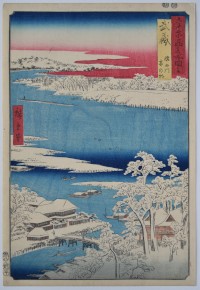
Click here to view image full size.
Musashi, Sumidagawa, yuki no ashita, “Musashi [Province], Sumida River, Morning after Snow.” From a set of 69 prints [Dai Nihon] Rokujuyoshi meisho zue, “Famous Places in the Sixty-odd Provinces [of Japan]” published by b Koshimuraya Heisuke between 1853 and 1856, this being 1853.
Very fine impression and colour. Light album backing, otherwise fine condition. Signed Hiroshige ga.
Status: Sold
Utagawa HIROSHIGE (1797-1858)
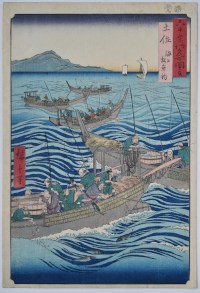
Click here to view image full size.
Tosa, kaijo katsuo tsuri, “Tosa [Province], Bonito Fishing at Sea.” Fishermen used fishing rods, rather than nets, to reduce the stress on the fish and maximise taste. Tosa, located on the southern coast of the island of Shikoku, was famous for its bonito. From a set of 69 prints [Dai Nihon] Rokujuyoshi meisho zue, “Famous Places in the Sixty-odd Provinces [of Japan]” published by b Koshimuraya Heisuke between 1853 and 1856, this being 1855.
Very fine impression and colour. Light album backing, otherwise fine condition. Signed Hiroshige ga.
Status: Sold
Utagawa HIROSHIGE (1797-1858)
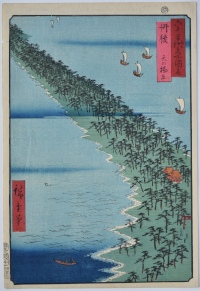
Click here to view image full size.
Tango Province, Amanohashidate (“Bridge to Heaven”). One of Japan’s three scenic views. The sandbar, located in Miyazu Bay, is said to resemble a pathway connecting heaven and earth. Also known for its fine pine trees. From a set of 69 prints [Dai Nihon] Rokujuyoshi meisho zue, “Famous Places in the Sixty-odd Provinces [of Japan]” published by b Koshimuraya Heisuke between 1853 and 1856, this being 1853.
Very fine impression and colour. Light album backing, otherwise fine condition. Signed Hiroshige ga.
Status: Sold
Shotei HOKUJU (1763-1825)
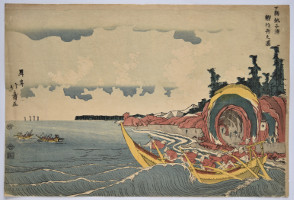
Click here to view image full size.
Shimosa Choshi no ura katsuo tsuribune, “Fishing for Bonito in Choshi Bay in Shimosa Province.” Hokuju, a pupil of Hokusai, produced a number of these fine “westernized” landscapes designed with stylised clouds, cubistic mountains and shadows cast by figures. This is one of the best. Bonito is a favourite fish in Japan where it is in the markets from around May each year. Choshin Bay has always produced the largest seafood catch in Japan. Hokuju produced a substantial body of work in this vein. However, he was not the only one. Okyo, Toyoharu, Hokusai, Kunitora, Kuninao and Shinsai also designed prints in this genre, as well as other artists producing examples. Interestingly, Hiroshige, the pre-eminent landscape artist, designed nothing like this. Indeed, the influences flowed the other way before too long, Hiroshige being a favourite of the Impressionists. This is the rare first edition published by Eijudo, c. 1820. His landscapes were republished by Yamamoto. Rare.
Fine impression and colour. Very good condition. Full size. Signed Shotei Hokuju ga.
Status: Sold
Utagawa HIROSHIGE (1797-1858)
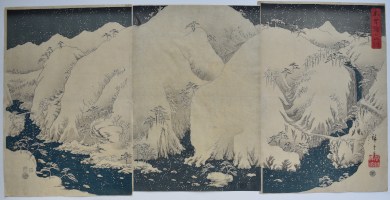
Click here to view image full size.
Kisoji no Yamagawa, “Mountain River on the Kiso Road.” One of Hiroshige’s most iconic images: Snow from an untitled set of three Setsugekka (“Snow, Moon, Flowers”) triptychs. The other two being Moon at Kanazawa and Whirlpools at Awa. The Setsugekka theme was taken from a poem by Tang dynasty poet Bai Juyi (Haku Rakuten). It’s a metonym for beautiful views, etc. This part of the Kiso Road was particularly treacherous but it’s not possible to identify the exact location and Hiroshige most likely used a certain amount of artist’s license. Published by Okasawaya Taheiji, 1857, a year before his death.
Fine impression and colour. Centre sheet lightly backed and slightly trimmed, otherwise very good condition. Signed Hiroshige hitsu with Bokurin Shokoku seal.
Status: Sold
Keisai EISEN (1790-1848)
Click here to view image full size.
Edo Ryogokubashi noryo no yakei, “View of an Evening Cooling Off at the Ryogoku Bridge, Edo.” Shows a multitude of boats beneath the bridge, fireworks above. Published c 1829.
Fine, early impression. Fine colour and condition. Signed Eisen ga.
Status: Sold
Ichiryusai HIROSHIGE (1797-1858)
Click here to view image full size.
An extremely rare uncut fan print: Kominato in Awa Province from Boso meisho, Famous Places in Awa, Kazusa and Shimosa Provinces. Shows beauties viewing the bay. Another impression illustrated in Hiroshige no uchiwae, Hiroshige Fan Prints, Okuda, Atsuko, Unsodo, 2010, no 91, p 68 (plus two others from the set). Five other designs presently known: Hoda Coast; Mount Kiyosumi; Mount Fuji from Kisarazu; Mount Kano, and Kisarazu in Kazusa Province. Published by Tsujiya Yasubei, 12/1852. Certainly one of the few impressions extant.
Very fine impression, colour and condition. Signed Hiroshige ga.
Status: Sold
Ichiryusai HIROSHIGE (1797-1858)
Click here to view image full size.
Mount Haruna in snow, Kozuke Province.One of the best designs from Rokuju yoshu meisho zue, “Famous Places in the Sixty-odd Provinces.” The series published by Koshimuraya Heisuke between 7/1853 and 3/1856 (this being 8/1853).
Very good impression and colour. Margins trimmed a little, otherwise very good condition. Signed Hiroshige ga.
Status: Sold
Ichiryusai HIROSHIGE (1797-1858)
Click here to view image full size.
Masaki yukibare no zu, “Clear Weather After Snow at Masaki” from a Toto Meisho, “Famous Sights of the Eastern Capital” set published by Kikakudo (Sanoki), the seal in red in right margin c 1832-35. There is confusion over how many prints belong to this series: The original set of twenty-one prints seems to have been extended to fifty-five in c 1839-42. The temple, under a deep layer of snow, is shown on the far shore. In the foreground two figures in yellow straw coats navigate the river.
Very fine impression. Fine colour. Later editions have the black seal of Sanoki in right margin. Very slight centre fold and two backed pinholes; trimmed just on the black title slip on right, otherwise fine condition. Signed Hiroshige ga.
Status: Sold
Ichiryusai HIROSHIGE (1797-1858)
Click here to view image full size.
Returning boats at Yabase, Yabase kihan, from an upright Omi Hakkei set. Published by Uoya Eikichi, 1857.
Fine impression and colour. Slight centre fold, otherwise very good condition. Signed Hiroshige ga
Status: Sold
Katsushika HOKUSAI (1760-1849)
Click here to view image full size.
A poem by Fujiwara no Yoshitaka (954-974) from Hyakunin isshu uba ga etoki, the “Hundred Poems Explained by the Wet Nurse.” Published by Eijudo and Iseri, c 1835-6. Although obviously intended to be a set of 100 prints, only 27 are known plus drawings for others. The poet speaks of a trivial life prior to meeting his lover. Two women and their companions relax after a bath admiring the view across water. Steam rises from the bath and two cormorants are seen on the left. A languid scene and one of Hokusai’s most beautiful designs.
Fine impression. Very good colour. Two states are known: the printers quickly discovered that the red seal at left was not easily discernible and cut the block to correct this. This is the first state but the seal can hardly be seen except on the reverse. Signed Zen Hokusai.
Status: Sold
Ichiryusai HIROSHIGE (1797-1858)
Click here to view image full size.
Suruga Satta no kaijo, “The Sea at Satta, Suruga Province” from Fuji sanjurokkei, “The Thirty-Six Views of Fuji.” The best design from the set published by Koeido (Tsutaya Kichizo), 4/1858. A huge wave breaks on the right releasing a flock of chidori. These birds were supposed to originate from the spume of these waves. Originally travellers on the Tokaido had to traverse the base of the cliff, to the left. However in 1655 a pass was cut in the cliff above. Fuji rises above the bay of Kiyomi. A very popular print.
Fine impression and colour. One or two very minor marks, otherwise very good condition. Signed Hiroshige ga.
Status: Sold
Ichiryusai HIROSHIGE (1797-1858)
Click here to view image full size.
The Sanza Theatre, Saruwaka-cho showing women on the balcony of a tea-house overlooking the street from an oban set Edo Meisho of approx. 45 prints published by Yamada-ya, 1853 – 1858, half being published in 1853. This design published 1858.
Fine impression and colour. Slight centre fold, otherwise good condition. Signed Hiroshige ga.
Status: Sold
Katsushika HOKUSAI (1760-1849)
Click here to view image full size.
Yoshiwara Station from a chuban Fifty-three Stations of the Tokaido. The set of 55 prints published by Iseya Rihei, c 1806. Unsigned but the original wrapper evidently had Hokusai’s signature. Two women, a man and boy press grapes.
Fine impression. Extremely fine colour. One small repaired wormhole near edge, otherwise fine condition.
Status: Sold
Ichiryusai HIROSHIGE (1797-1858)
Click here to view image full size.
Masaki yukibare no zu, “Clear Weather After Snow at Masaki” from a Toto Meisho, “Famous Sights of the Eastern Capital” set published by Kikakudo (Sanoki), the seal in red in right margin c 1832-35. There is confusion over how many prints belong to this series: The original set of twenty-one prints seems to have been extended to fifty-five in c 1839-42. The temple, under a deep layer of snow, is shown on the far shore. In the foreground two figures in yellow straw coats navigate the river. This is the best example of this design I have seen since the impression in my Catalogue 7, 1971, no 12.
Very fine impression and colour. Later editions have the black seal of Sanoki in right margin. Fine condition. Signed Hiroshige ga.
Status: Sold
Ichiryusai HIROSHIGE (1797-1858)
Click here to view image full size.
Kawaguchi no watashi Zenkoji, “Ferryboats to Zenkoji Temple at Kawaguchi” from Meisho Edo hyakkei, the “One Hundred Views of Edo.” The set published between 1856 and 1858 (this being 1857) by Uoya Eikichi. This fine example of a first edition with the extra large margins has never been in an album.
Superb impression of the first edition with beautiful bokashi and mica. Very fine colour and condition. Signed Hiroshige ga.
Status: Sold
Hasegawa SADANOBU I (1809-1879)
Click here to view image full size.
A chuban landscape from a set of at least 30 prints: Miyako meisho no uchi, “Famous Places in the Capital [Kyoto].” This design, Shijo-bashi yori Nawate-dori Yamato-bashi o nozumo, “View from Shijo Bridge Towards Yamato Bridge at Nawate Street.” A fine set, inspired by Hiroshige, but not slavish copies and some excellent designs (as the snow scene here). Published by Wataya Kihei-ban, 1858.
Fine, early impression. Fine colour and, apart from the usual imperceptible fold, fine condition. Signed Sadanobu ga.
Status: Sold
Hasegawa SADANOBU I (1809-1879)
Click here to view image full size.
A chuban landscape from a set of at least 30 prints: Miyako meisho no uchi, “Famous Places in the Capital [Kyoto].” This design, Ryoan-ji yuki [no] akebono, “Snowy Dawn at Ryoan-ji Temple.” A fine set, inspired by Hiroshige, but not slavish copies and some excellent designs (as the snow scene here). Published by Wataya Kihei-ban, 1858.
Fine, early impression. Fine colour and, apart from the usual imperceptible fold, fine condition. Signed Sadanobu ga.
Status: Sold
Hasegawa SADANOBU I (1809-1879)
Click here to view image full size.
A chuban landscape from a set of at least 30 prints: Miyako meisho no uchi, “Famous Places in the Capital [Kyoto].” This design, Toganoo monzen uchu, “Temple Entrance at Toganoo in the Rain.” A fine set, inspired by Hiroshige, but not slavish copies and some excellent designs (as the rain scene here). Published by Wataya Kihei-ban, 1858.
Fine, early impression. Fine colour and, apart from the usual imperceptible fold, fine condition. Signed Sadanobu ga.
Status: Sold
Utagawa HIROSHIGE (1797-1858)
Click here to view image full size.
Mochizuki from Kisokaido rokujukyutsugi no uchi, “The Sixty-nine Stations of the Kisokaido.” The set of seventy prints was started by Eisen and published by Hoeido in 1835, but in 1837 Hiroshige took over and completed the series with the publisher Iseya Rihei (Kinjudo). Shows travellers on the Uryu Slope between Yawara and Mochizuki. Mount Tateshima to the right. One of the finest designs from the set.
Fine early impression with gradation over the moon and woodgrain showing. Fine colour. Very slight centrefold and soil in left margin, otherwise very good condition. Signed Hiroshige ga.
Status: Sold
Utagawa HIROSHIGE II (1826-1869)
Click here to view image full size.
A view of Ama-no-hashidate, Tango Province, from Shokoku meisho hyakkei, the “Hundred Views of Famous Places in the Provinces.” An uncompleted set of 81 prints published by Uoya Eikichi between 1859-1861 (this being 10/1859). The place name can be translated as “Bridge to Heaven” and it’s considered to be one of the most beautiful areas in Japan. Seen here under a full moon.
Superb impression of the first edition: One of the earliest pulls from the blocks. Fine colour and condition. Signed Hiroshige ga.
Status: Sold
Utagawa KUNIYOSHI (1797-1861)
Click here to view image full size.
Nichiren struggling up a snow-covered mountain near Tsukahara on the Island of Sado. The best design from Koso goichidai ryakuza, the “Illustrated Abridged Biography of the Founder.” Nichiren being the founder of the Buddhist Nichiren sect ( Nichiren shu – Kuniyoshi being a follower ) and indeed the set of ten prints may have been commissioned to mark the 550th anniversary of his death. Published by Iseya Rihei, c 1831. Like many great landscapes, there exist different states which causes confusion over which is the earliest. The basic difference is that the design is known with and without a horizon line and that there is at least one impression where the uninked, blind-printed line can be seen in a raked light (as indeed it can on this impression). It has been asserted that those impressions without are the earliest; however, it seems from this that the sumi block was probably cut initially with the line but the publishers thought that it looked aesthetically better without printing it, and it was subsequently removed. In any case, this is an extremely rare print and most surviving examples appear to be similar in impression. There is a break in the border to the left of the bottom of Kuniyoshi’s signature which could give a guide to the earliest states, but as this is often painted in, it is not reliable. The composition is based on a design in the illustrated book Bumpo sansui gafu by Kawamura Bumpo, published posthumously in 1824. Although not from a landscape set, this is considered one of the great 19th century landscapes.
Fine impression and colour. Beautiful gradation with splashed gofun (oxidised). Slight centre fold, otherwise very good condition. Signed Ichiyusai Kuniyoshi hitsu.
Status: Sold
Ichiryusai HIROSHIGE (1797-1858)
Click here to view image full size.
The entrance to the Yoshiwara from a rare set of fourteen prints, Famous Places of the Eastern Capital, published by Sanoki in 1840-2.
Fine impression, colour and condition. Signed Hiroshige ga.
Status: Sold
Utagawa HIROSHIGE (1797-1858) and Utagawa KUNISADA (1786-1865)
Click here to view image full size.
A triptych showing Mitsuuji, the romantic hero of the Inaka Genji (“A Rustic Genji”) accompanied by a beauty looking out across a snow-covered garden to where a group of girls are building a giant snow rabbit. Hiroshige and Kunisada collaborated on a number of these Genji triptychs in the 1850s and this is one of the most charming. Published by Moriya Jihei of Kinshodo, 12/1854 (and therefore probably in anticipation of the following year, which was a Year of the Rabbit).
Fine impression. The early state with gradation behind the rabbit and bokashi on stream and in the sky. Fine colour. Fine condition. Signed Toyokuni ga on two outside panels and Yuki no kei oju, “Snow landscape by request” Hiroshige hitsu.
Status: Sold
Ichiryusai HIROSHIGE ( 1797-1858 )
Click here to view image full size.
Numazu, Shizuoka Prefecture, from the so-called “Upright Tokaido”, Gojusan tsugi meisho zue. The 12th of the 53 Stations. At its peak in Edo times the town had 1200 buildings. It is now Numazu City. The old adage that familiarity breeds contempt certainly applies to this set, which was reprinted many times. Early printings, as here, enable us to appreciate this underrated series. One of the two snow scenes from the set showing figures crossing one of two trestle bridges. Published by Tsutaya, 1855.
Very good impression, colour and condition. Signed Ichiryusai Hiroshige ga.
Status: Sold
Ichiryusai HIROSHIGE (1797-1858)
Click here to view image full size.
Fireworks over Ryogoku Bridge from a rare set of fourteen prints, Famous Places of the Eastern Capital, published by Sanoki in 1840-2.
Fine impression, colour and condition. Signed Hiroshige ga.
Status: Sold
Utagawa KUNIYOSHI (1797-1861)
Click here to view image full size.
A view of Hara, Yoshiwara and Kanbara from Tokaido gojusan eki (shishuku meisho), “ Famous Views of the Fifty-three Stations of the Tokaido (Four at a Time)” although the set actually varies, showing between three and six per sheet. The set of twelve designs published by Tsuruya Kiemon and Tsutaya Kichizo, c 1835.
Very fine impression of the first edition. Fine colour. Some soil on reverse, otherwise very good condition. Signed Ichiyusai Kuniyoshi shuku zu (“Drawn together by Ichiyusai Kuniyoshi”).
Status: Sold
Utagawa KUNIYOSHI (1797-1861)
Click here to view image full size.
Travellers viewing Mount Asama. Usui-toge yori Asama o miru zu, “A View of Mount Asama from Usui Pass.” From Kuniyoshi’s best landscape set. Of the utmost rarity with most extant impressions differing. This and the impression in the Museum of Fine Arts, Boston, are similar, without the smoke coming from the cone of Asama (the most active volcano on Honshu). Other impressions are in: The British Museum, 1948, 0410, 0. 108, which has gradation up the left side of the mountain; the Metropolitan Museum of Art, JP 1424, with gradation down from the summit; and Worcester Art Museum which is similar to the Mets, 1901.692. Published by Yamaguchiya Tobei, c 1836. I have only had one other impression in over forty-five years of dealing.
Very good impression, colour and condition. Signed Ichiyusai Kuniyoshi ga.
Status: Sold
Ichiyusai HIROSHIGE II (1829-1869)
Click here to view image full size.
A view of a smoking Mt Asama, Shinano Province from Shokoku meisho hyakkei, the ‘One Hundred Views of Famous Places in the Provinces’. Published by Uoei, Sheep 9 ( 1859 ).
Very good impression, colour and, apart from one small spot, very good condition. Signed Hiroshige ga.
Status: Sold
Utagawa HIROSHIGE II (1826-1869)
Click here to view image full size.
The Seven Ri Beach, Sagami Province, Sagami Shichirigahama, from an unfinished set Shokoku meisho hyakkei, “One Hundred Views of Famous Places in the Provinces.” Published by Uoya Eikichi between 1859 and 1861 (this being 1859). A popular area during Edo times as one could get a view of both Mount Fuji and Enoshima at the same time. The Ri in the title is an old unit of measurement. This design obviously bears comparison with both Hiroshige’s “wave” from the Thirty-Six Views of Fuji and Hokusai’s “wave” from a series with same title.
Superb impression of the first edition. (Extremely rare in this state.) Very fine colour and condition. Signed Hiroshige ga.
Status: Sold
Utagawa HIROSHIGE II (1826-1869)
Click here to view image full size.
The Dragon’s Maw Mountain, Bizen Province, Bizen tatsu-no-kuchi yama from an unfinished set Shokoku meisho hyakkei, “One Hundred Views of Famous Places in the Provinces.” Published by Uoya Eikichi between 1859 and 1861 (this being 1860). Shows a lone figure battling a heavy rainstorm in a steep-sided canyon.
Superb impression and colour. The extremely rare first edition with gradation on the figure’s straw cape and bokashi clouds. The best quality red pigment is used and double-printed in the cartouches. Fine condition. A masterpiece in this state. Signed Hiroshige ga.
Status: Sold
